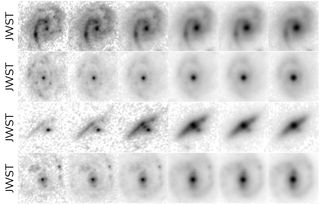Key Takeaways:
- Galactic Surprise: Recent data from the James Webb Space Telescope (JWST) challenges previous notions about the appearance and evolution of early galaxies.
- Early Galaxy Formation: Contrary to prior beliefs, delicate galactic structures like spiral arms and bars may have emerged as early as 3.7 billion years after the Big Bang, reshaping our understanding of galaxy formation.
- Astronomical Revelation: Astronomers must reevaluate their comprehension of how the first galaxies formed and evolved over the past 10 billion years, based on these groundbreaking findings.
- JWST’s Precision: The JWST, with its unparalleled infrared capabilities, has surpassed the Hubble Space Telescope in revealing early galactic structures, based on an analysis of nearly 4,000 galaxies.
- Galactic Evolution: This research signifies the need for fresh theories to elucidate the evolution of galaxies over the course of the universe’s existence.

The James Webb Space Telescope (JWST) has recently presented a cosmic revelation, reshaping our understanding of the universe’s early galaxies. Contrary to previous beliefs, these ancient galaxies, dating back to 3.7 billion years after the Big Bang, displayed intricate structures akin to modern galaxies such as the Milky Way. This groundbreaking insight prompts astronomers to reevaluate their theories regarding the formation and evolution of the first galaxies over the past 10 billion years.
For decades, scientists assumed that newly formed galaxies immediately after the Big Bang lacked distinct features like spiral arms or bars, with such structures evolving billions of years later. However, the JWST’s unprecedented infrared capabilities have challenged this notion. This transformative research draws on an analysis of nearly 4,000 galaxies, making it the most extensive study using JWST data to date.
Intriguingly, the JWST’s findings coincide with another revelation from a separate group of researchers, indicating that early galaxies produced fewer heavy elements than previously thought. However, the connection between a galaxy’s chemical composition and its transformation into a well-defined structure remains a subject of exploration.
Traditionally, our insights into galaxy evolution relied on data from the Hubble Space Telescope, a venerable tool in its own right, but with limitations in resolution. The JWST’s high-resolution data has delved deeper into the cosmos, demonstrating that early galaxies possessed well-defined structures, contrary to earlier assumptions.
This research categorizes the sample set of early universe galaxies based on shape, differentiating between disks, point sources, and spheroids. Further classifications as smooth or structured galaxies revealed that well-defined structures in the universe formed much earlier than previously believed, aligning with the Hubble Sequence’s classification of galaxies by visual properties.
The profound implications of these findings signal a need for fresh ideas to elucidate the intricate journey of galaxies over the past 10 billion years. This epochal discovery places the James Webb Space Telescope at the forefront of reshaping our cosmic narrative, unlocking the enigma of early galaxies and their evolution.
This research is described in a paper published Sept. 22 in The Astrophysical Journal.


